[Part I of this article describes Dodge’s commission to paint a mural for the 1893 World’s Columbian Exposition and his work to create The Glorification of the Arts and Sciences.]
PART II: THE PROCESSION BEFORE THE THRONE OF APOLLO
“… illuminated by the opal-like circle of light at the summit, Dodge’s great picture crowns the whole, with its circling procession of arts and sciences, gods and muses, nymphs and graces, and Apollos radiant in the midst.”
—Lawrence L. Lynch in “Against Odds: A Detective Story” (1894)
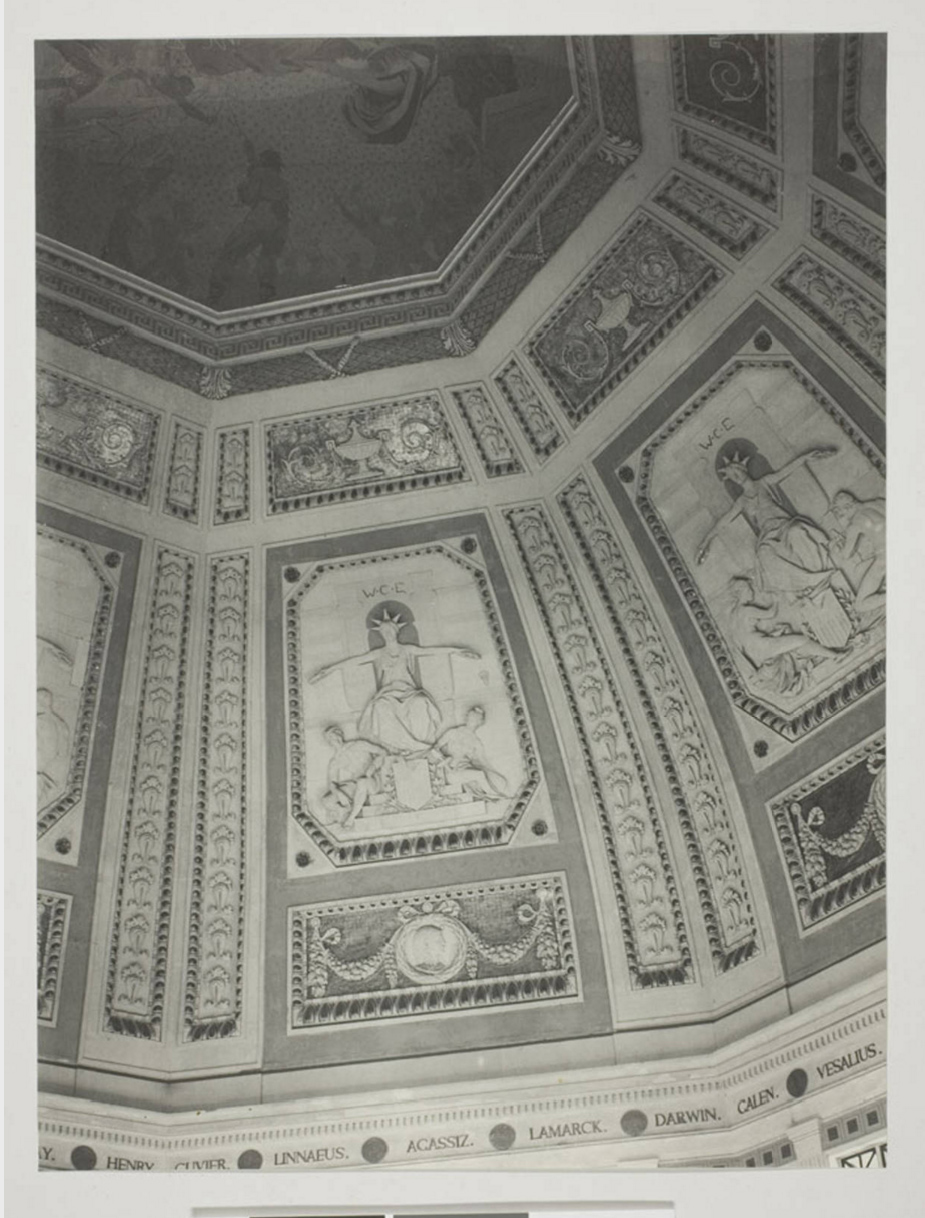
Figure 10. A photograph by C. D. Arnold of part of the Administration Building dome. A portion of Glorification of the Arts and Sciences, showing the front of the horses drawing the Parthenon chariot, is barely visible in the top left. [Image from the Ryerson & Burnham Library at the Art Institute of Chicago.]
With laurel-crowned brow and arms outstretched
Despite an abundance of photographs, drawings, and paintings of the Columbian Exposition buildings and grounds, images of the Glorification of the Arts mural are rare. A few photographs (Figures 10 and 11) show only partial views of the dome, and most suffer from being washed out by bright sunlight coming through the oculus. Some newspaper illustrations depict sections of the mural (Figure 12), and several studies made by Dodge of figures within the larger composition were reprinted in contemporary periodicals (Figures 14-16). Surviving in a scrapbook in the Newberry Library in Chicago is a pencil-and-ink sketch of the mural by Dodge, signed and dated by Richard Hunt on April 21, 1892. None of these show the painting in color. A smaller study of Glorification that has survived and which recently has been restored (see below) gives a better idea of what the dome painting looked like in full, glorious color.

Figure 11. Decoration of the Dome of the Administration Building, showing three segments of Glorification of the Arts and Sciences, from The Graphic History of the Fair. Graphic Co., 1894, p. 57.
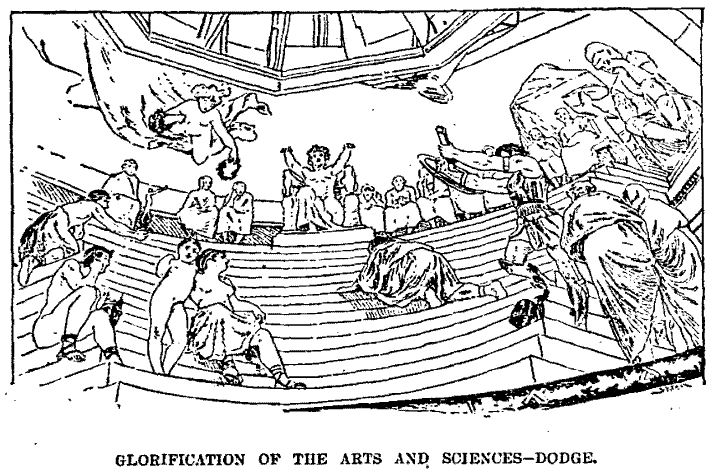
Figure 12. An illustration of the central section of Dodge’s Glorification of the Arts and Sciences, showing Apollo on his throne, from the Chicago Daily Tribune, Nov. 27, 1892, p. 33.
The composition of Glorification of the Arts and Sciences is depicted in the cartoon shown in Figure 13, with letters identifying the characters described below.
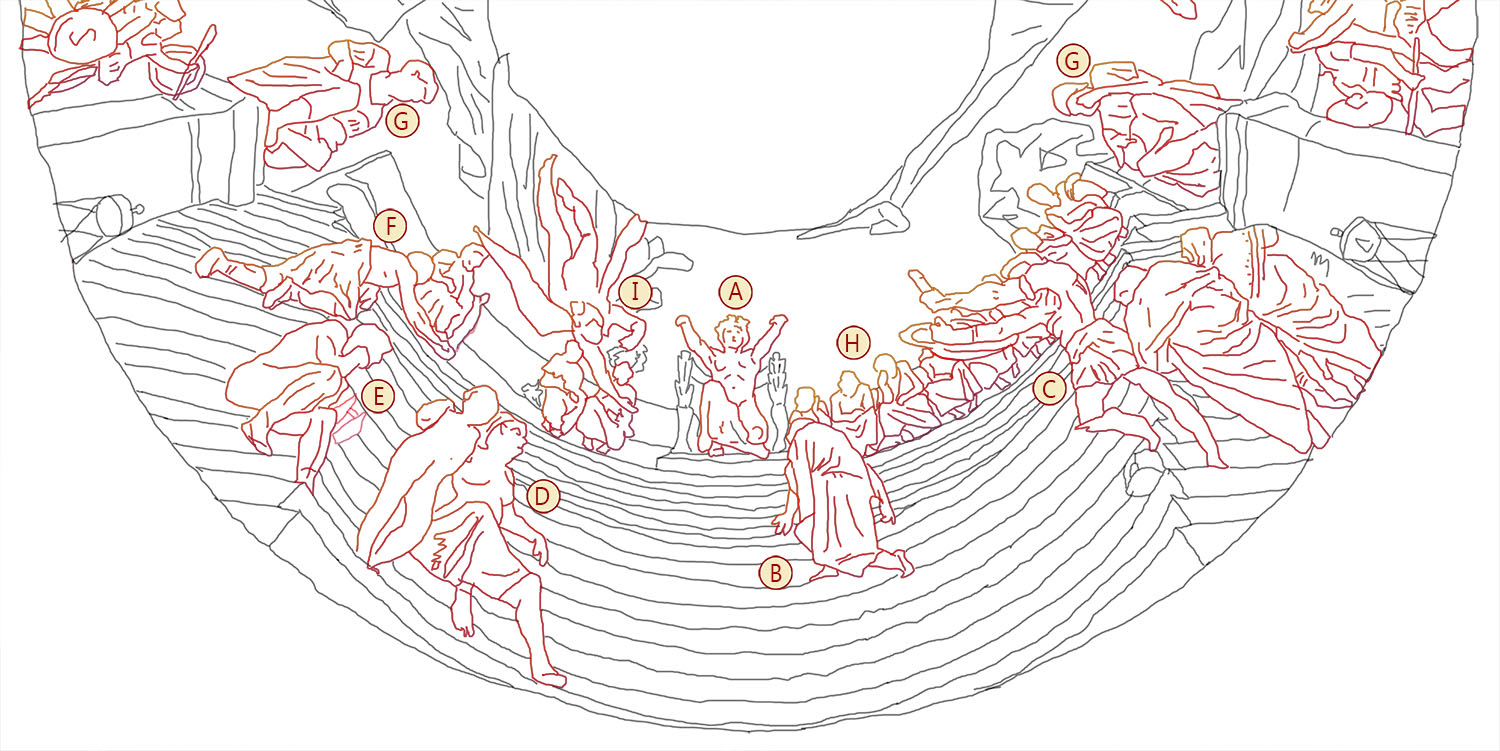
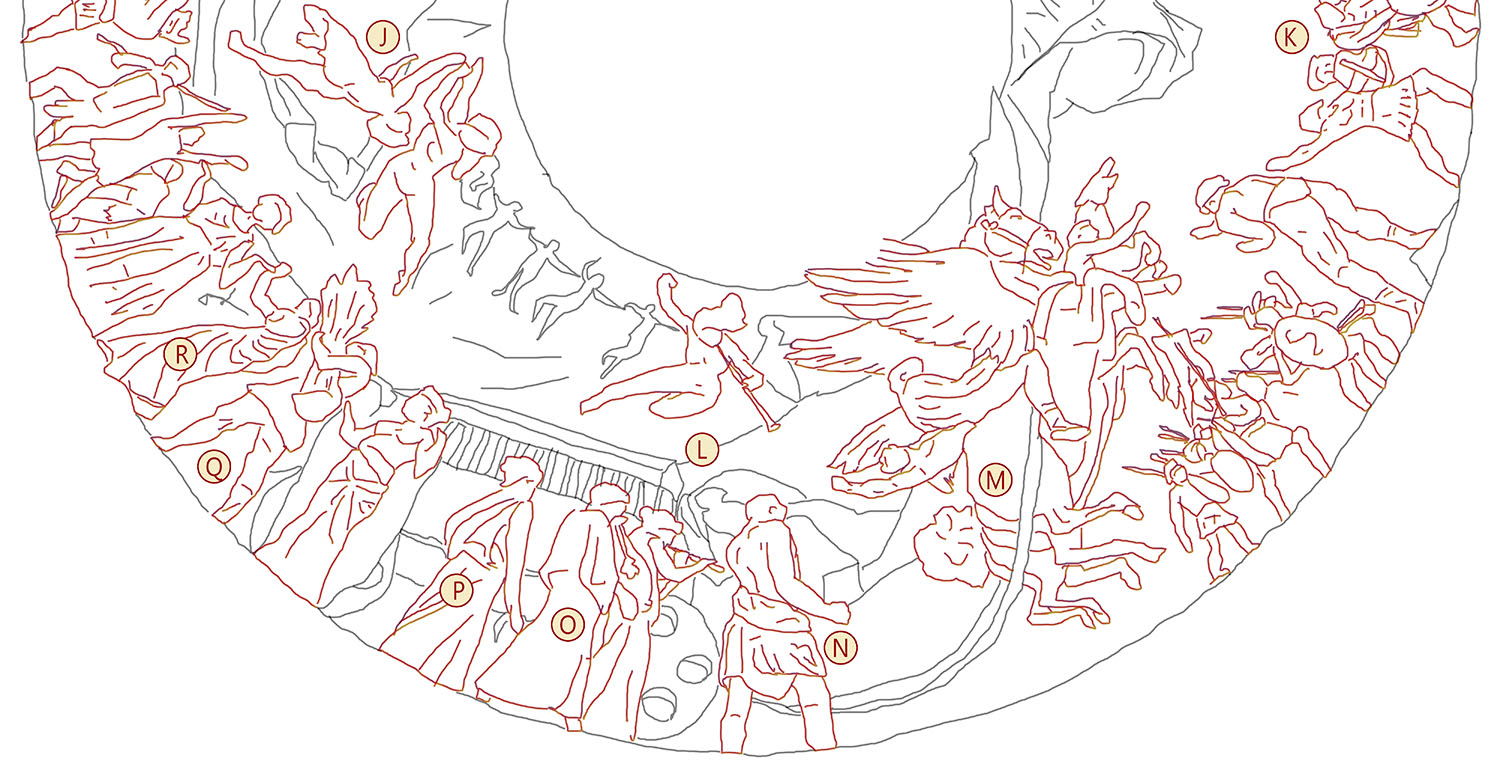
Figure 13. A cartoon drawing of two halves of Dodge’s Glorification of the Arts and Sciences, with letters to identify the characters described in the text.
In the center of the painting, seen on the portion of the dome opposite the east entrance of the Administration Building, the Greek god Apollo sits upon his Olympian throne at the top of a flight of white marble stairs [A]. With laurel-crowned brow and arms outstretched, he bestows honors upon figures representing the victors in war and the leaders in the arts and sciences (Figure 14).
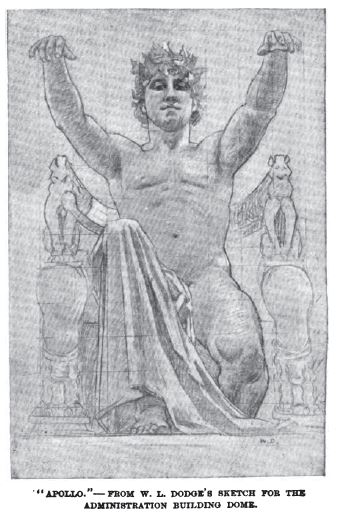
Figure 14. Dodge’s study of “Apollo” from McDougall “Art Aspects of the World’s Fair” in Frank Leslie’s Popular Monthly, April 1893.
A male figure symbolizing Art kneels on the steps before Apollo [B]. To the right stands a Greek warrior, rendered in orange and purple, who approaches carrying his sword and shield [C]. On the left side of the stairs sits a woman with a beautiful and naked child [D], representing Motherhood. Further left, a seated figure holds a lyre [E] and a kneeling character presents a small statue to Apollo [F].
At the base of the steps, on each side, are pedestals supporting statues [G] based upon those of Giuliano and Lorenzo on the Medici tombs in the Church of San Lorenzo in Florence, Italy. In front of each is a tripod burning incense.
Seated behind Apollo is a semicircle of Greek wise men [H]. In the sky above, a nymph extends a laurel wreath [I]. Other angelic figures in the sky [J] draw back a theater curtain from the center of the arena.
In a procession from both sides, other favorites representing the arts, sciences, and industries approach Apollo bearing gifts or displaying trophies. Groups of Greek soldiers cheer the victors receiving honors [K].
On the side of the dome directly opposite Apollo, Architecture brings an offering of a model of the Parthenon [L], carried on a chariot drawn by four winged horses mounted by muscular men [M] (Figure 15).
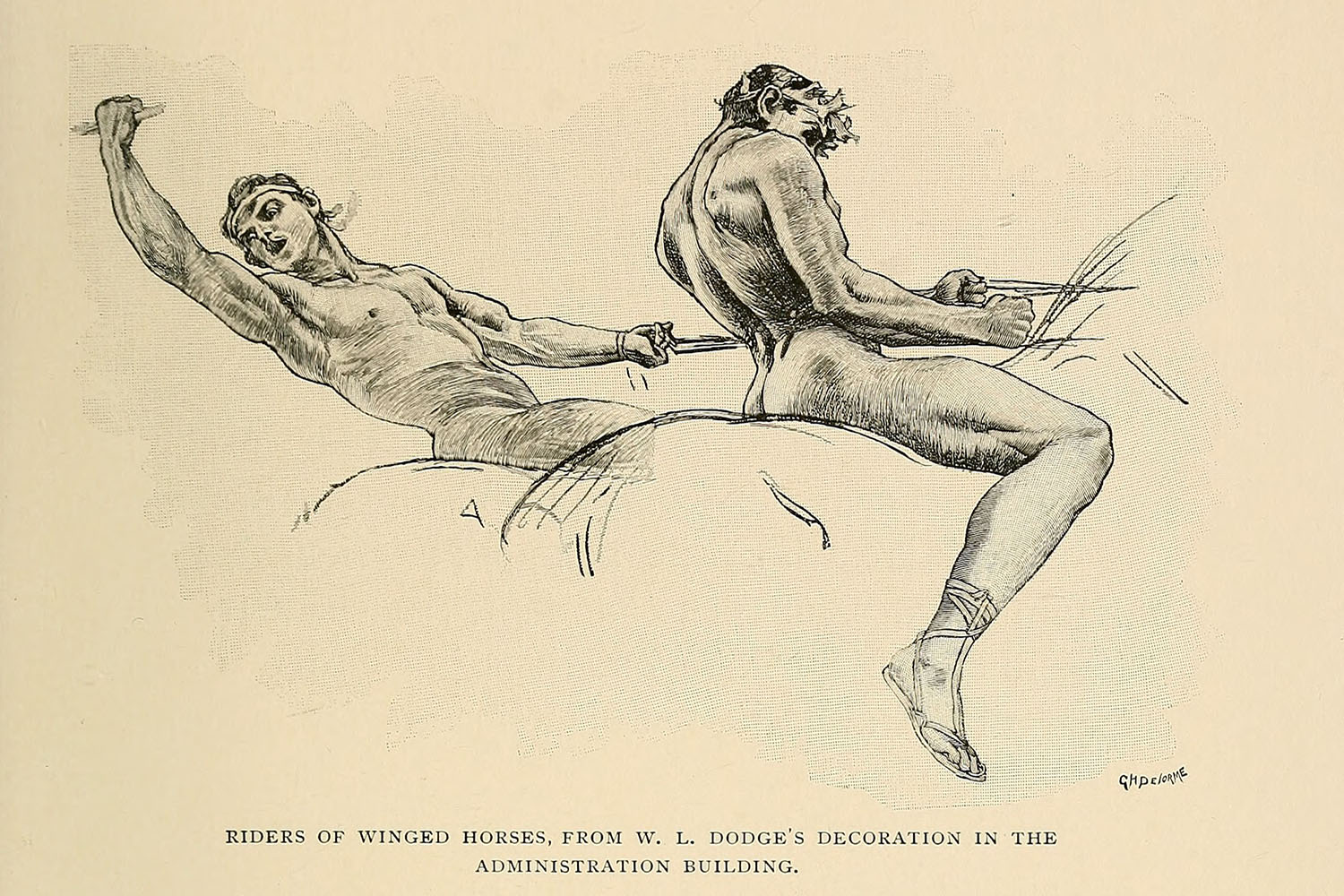
Figure 15. Dodge’s study for “Riders of Winged Horses” who pull the chariot of the Parthenon model, from “The Decorations of the Exposition” by F.D. Millet in Scribner’s Magazine, October 1892, p. 1.
Beside the architectural van, the representative of Sculpture [N] bears in his arms a model of the Venus de Milo. Two representatives of Music follow [O], and after them come figures symbolizing Horticulture carrying a flower [P] (Figure 16), Agriculture carrying a sheaf of wheat [Q], and Dancing [R]. Other figures in the procession—possibly representing the Ceramic Arts, Textiles, and Sciences—bring the eye back around to the statue on the right of Apollo.
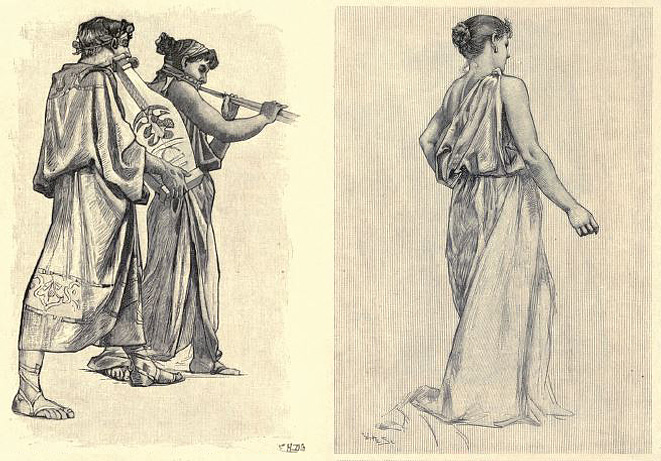
Figure 16. Dodge’s study for “Musicians” (left) and “Female Figure” representing Horticulture (right), from “The Decorations of the Exposition” by F.D. Millet in Scribner’s Magazine, October 1892, p. 1.
Contemporary sources note that ninety-five figures appear in the composition, [Truman, 206] but the number appears to be closer to fifty, in agreement with a statement by Dodge’s brother. [“Decorative Figures”, 156] For a sense of scale, the figures in the foreground of the painting were twenty-five to thirty feet in height, which would make them appear about ordinary size when viewed from the floor below. [Truman, 206]
Shimmering color which is very beautiful
Highlighting the strength of Dodge’s Glorification, the New York Tribune wrote that “it has color,” and offered this description:
“The dominant tones are found in the blue sky, in the tawny draperies which partially hide the latter, in the violet and lavender robes of some of the figures and in the flesh color of those others which are entirely or partially nude. The dark notes struck by the Medici statues have been mentioned. What the spectacle will be like when it is uncovered can only be guessed at.” [“Architecture at the Fair”]
Artist Frank Millet noted that the group of nude flying female figures “contrasts agreeably with the clear blue of the sky background, against which the principal groups are shown in strong relief.” [Millet, 700] The Critic wrote:
“In the central part, the decoration has a kind of pale, shimmering color which is very beautiful. There are notes of purple and green in the midst of this delicacy, and about it the color deepens and strengthens, keeping always, however, a certain cool transparency, a serene and limpid radiance. Several of the chief figures—notably the kneeling artist, the beautiful half-nude woman, and the warrior in orange and purple—are superbly effective in themselves and in their relation to the composition.” [“Chicago Letter”]
A very clever piece of mural painting
Most art critics were impressed by the young painter’s mural for the World’s Fair. Royal Cortissoz (1869–1948) was an American art historian and long-time art critic for the New York Tribune. (He provided the inscription above the statute of Lincoln at the Lincoln Memorial in Washington, D.C.: “In this temple / As in the hearts of the people / For whom he saved the Union / The memory of Abraham / Lincoln / Is enshrined forever.”) Cortissoz complimented Dodge’s “draftsmanship and good construction” for Glorification, writing that:
“… there is a virility in his work which makes it stirring. The procession before the throne of Apollo which he calls Glorification of the Arts and Sciences is striking in arrangement and color, in its details and its general effect, and is a very clever piece of mural painting; but it enters into the background of the Fair militant even less than the domes of the Liberal Arts Building. The lantern of the Administration Building’s dome is nearly three hundred feet above the level of the pavement, so there is naturally very little cooperation between the color-values of Mr. Dodge’s painting and those of the crowd which surges beneath it.” [Cortissoz, 333]
The sculptor Karl Bitter (1867–1915), whose work adorned the exterior and interior of the Administration Building, also was impressed with the dome mural, but pointed out the same problem of viewing the mural:
“There is no question of the grandeur, and beauty of the interior. There is one flaw that detracts not a little. Dodge’s huge and artistic painting, which crowns the whole work, can not be seen to advantage, owing to some fault in the construction. It is impossible to get a full view of the picture from any accessible point. It can be seen only in pieces, a few figures at a time, and the effect is almost spoiled. Too much of the picture is cut off by a lower dome, and standing directly in the center of the floor one can hardly see the work at all.” [A Week at the Fair, 68]
Writing in the New York Tribune, a critic reviewing Dodge’s sketches for the mural observed that “good drawing and a vigorous style in painting bodies, nude and draped, are the first essentials in mural painting, and Mr. Dodge has them.” [“Architecture at the Fair”] The critic also compliments “the firmness with which the figures stand on the ground, in their unstrained attitudes, in the virility with which they have been drawn and modelled,” and reports that “a wave of energy flows through the composition, which would be remarkable for its movement, for the genuine sense of a marching crowd of eager figures which it conveys, if for nothing else.” The critic levels fault, though, with Dodge’s depiction of the model Parthenon being pulled by chariot:
“This typifies architecture and does so, it may be added, with an originality which it is difficult to either praise or blame. It is ingenious and picturesque, it is very clever in a pictorial way. But the irresistible association of ideas makes it impossible to avoid a feeling that imaginatively, poetically, Mr. Dodge’s conception of architecture amounts to little upon this occasion. It seems a sacrilege to depict the fairest monument in the world in this toy fashion.” [“Architecture at the Fair”]
Writer and journalist Julian Hawthorne (1846–1934) was unimpressed with what he saw, writing this about both Bitter’s sculpture and Dodge’s painting for the building:
“I do not like the acrobatic groups of statuary in the corners of the Administration; nor am I much captivated by the fresco [sic] in the dome. The color is unsympathetic, and the design is rambling and ineffective. It is wiser to treat a dome as a solid surface, and decorate it accordingly.” [Hawthorne, 55]
Another reporter was even harsher, describing Glorification as a gigantic failure and criticizing “Mr. Dodge’s idiotic performance on the dome of the Administration Building” [Pierce, 436].
A popular guidebook offered this pithy advice to visitors of the Administration Building:
“On the upper dome the painting of The Glorification of the Arts and Sciences is pleasing in color, but the allegory will hardly capture popular attention. For those who have a special interest in mural decoration the dome will afford some profit.” [Underwood, p. 19]
Writing that Dodge has treated his subject “with a certain sumptuous majesty,” The Critic did note “grave faults in the drawing of certain figures and especially in the winged horses” and problems with “composition in two or three places,” but concluded:
“… nevertheless the work is a notable achievement. Mr. Dodge labored under great disadvantages in the matter of time and temperature, but he tried earnestly to give what was best in him, to reach the highest result of what he was capable … As the work of a very young artist this decoration is especially important, as indicating the heights that so much talent and ambition may yet dare to climb.” [“Chicago Letter”]
Some sources indicate that Dodge was awarded a prize for his Administration Building dome mural, [Bardin, 36] but he is not named among the awardees listed in the Revised Catalogue, Department of Fine Arts.
The heights that so much talent and ambition may yet dare to climb
The attention gained from his mural at the 1893 World’s Fair earned Dodge additional commissions in the coming years, most notably when he received in November 1894 an invitation (along with several other Columbian Exposition muralists) to create a set of murals for the new Thomas Jefferson Building of the Library of Congress in Washington. [Cole, 199] One of Dodge’s paintings for the Library directly references his earlier work at the Columbian Exposition.
Dodge’s 10-by-35-foot mural The Sciences (Figure 17), made for a lunette in the Northwest Pavilion on the second floor of the Library, depicts modern technologies in the composition, including a telegraph, telephone, steam engine, and chemical flasks. A familiar character, kneeling and garbed in a purple robe, takes the central position and here represents the inventor of the phonograph receiving his laurels from a winged figure. [Cole, 213]

Figure 17. Dodge’s mural The Sciences in the Library of Congress includes a familiar kneeling figure (right).
A second vestige of Dodge’s Columbian Exposition painting can be found in one of the murals he created for the 1915 World’s Fair, the Panama-Pacific International Exposition held in San Francisco. His allegorical Gateway of All Nations (Figure 18), which adorned a side wall under the grand arch of the Tower of Jewels, depicted the same nude male figure riding a white horse that appeared pulling the Parthenon in Glorification of the Arts. [Macomber, 46]
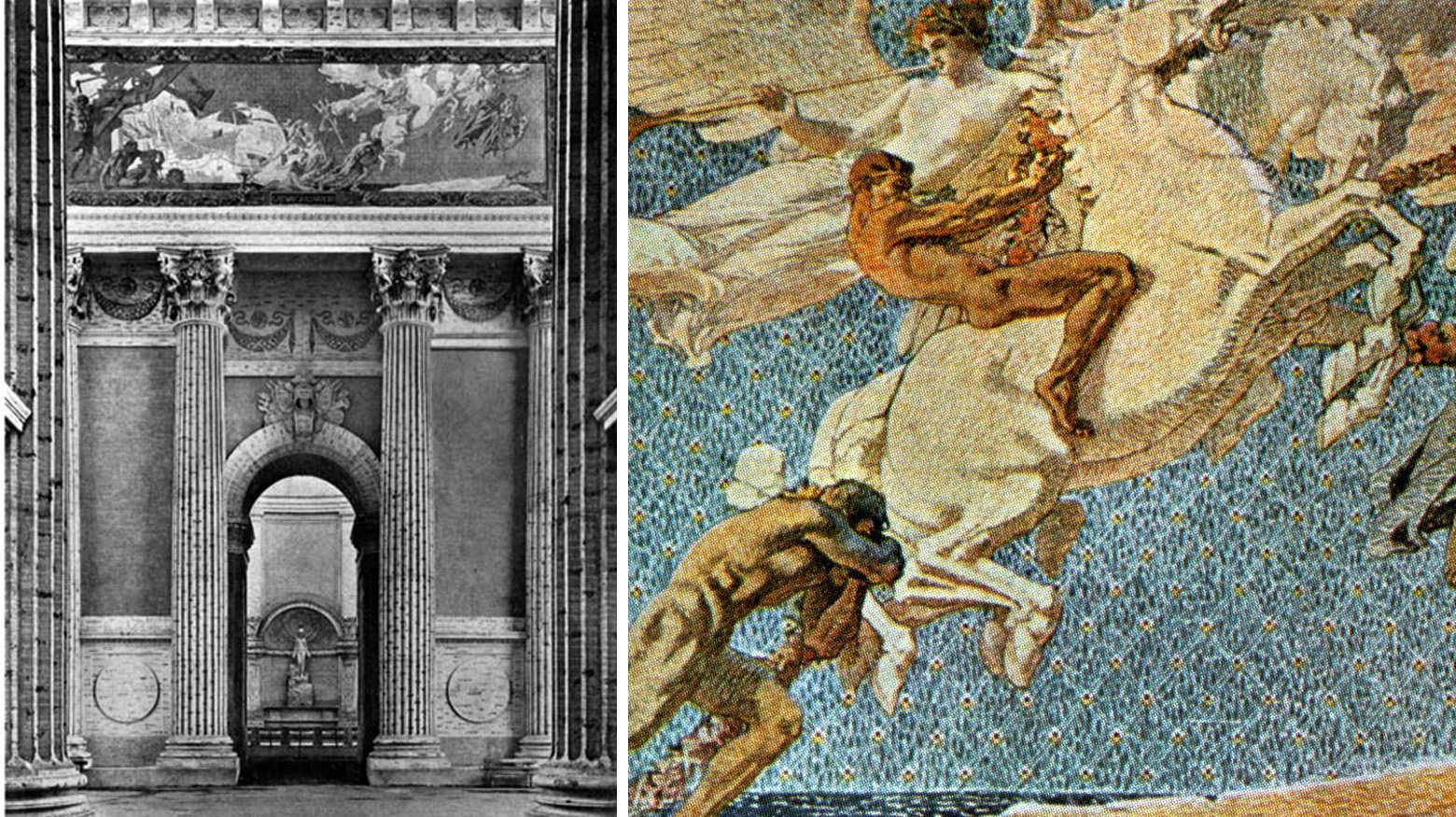
Figure 18. Dodge reused his nude male riding a horse in his Gateway of All Nations mural for the 1915 World’s Fair in San Francisco. Image from Macomber, Ben The Jewel City: Its Planning and Achievement; Its Architecture, Sculpture, Symbolism, and Music; Its Gardens, Palaces, and Exhibits. J. H. Williams, 1915.
Glorification Lost
As with much of the decorative art of the 1893 World’s Fair buildings, The Glorification of Arts and Sciences mural was intended to be ephemeral, and it soon was lost. In the year following the close of the Fair, buildings not destroyed by a series of fires (many set by arsonists) were picked clean by scavengers and eventually taken down by the wrecking ball (Figure 19). By January 1895, the former fairground was a site of desolation when the Chicago Daily Tribune reported that “the Administration Building, or the site where it stood, is marked by a lot of twisted girders, the remains caused by the fire, of that center whose illuminated dome by night was such a thing of wondrous beauty that once seen it could never be forgotten.” [“Where the White City Stood”] William Dodge’s work of wondrous beauty inside its dome presumably went down with it.
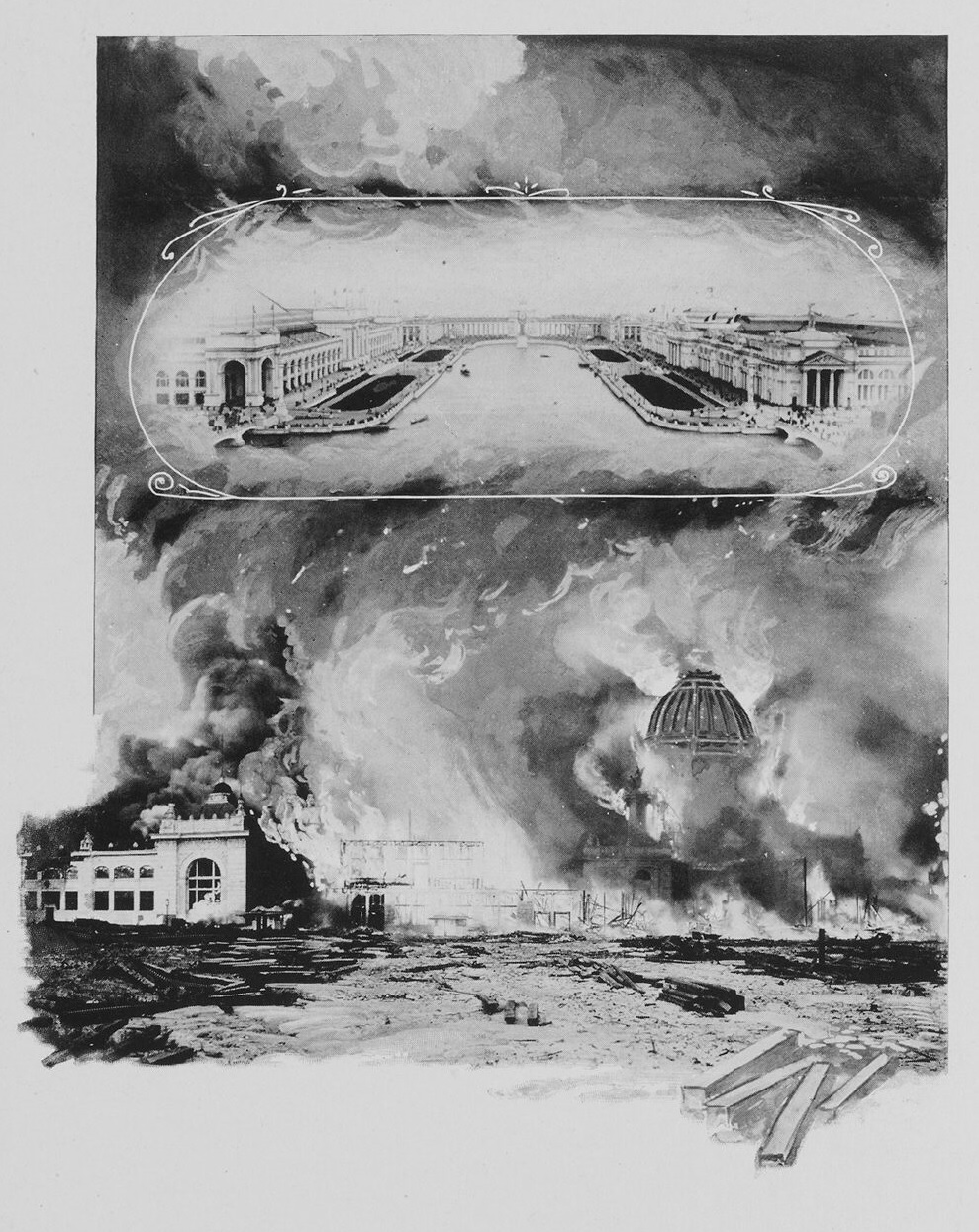
Figure 19. “Burning of Administration and Mines Building, with eastern view of Court of Honor and Peristyle” from The Vanishing Fair by H. H. Van Meter, Literary Arts Co., 1894.
Glorification Found
While William Dodge’s Glorification of the Arts and Sciences lived its short life decorating the dome of the White City headquarters, a smaller version of the painting found its way off the fairgrounds and survived in quiet anonymity for more than a century.
In 1999, after moving into their historic house in Riverside, Illinois, Judy and Allen Koessel became curious about the mural that adorned their foyer ceiling (Figure 20). Research led them back to the White City as they discovered that their painting was a smaller version of Glorification of the Arts and Sciences, most likely a study used by Dodge while working on his large-scale mural for the Administration Building dome.
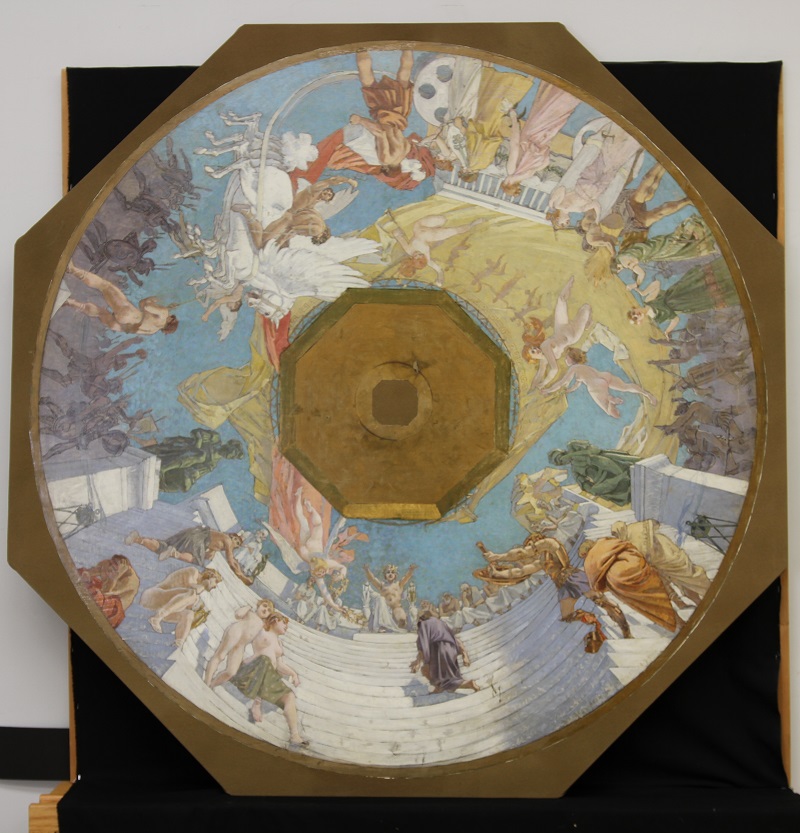
Figure 20. The restored William Dodge Glorification of the Arts and Sciences model painting. [Photograph courtesy Judy Koessel.]
Note: The Koessel’s painting will be on display at the Newberry Library as part of their exhibit, “Pictures from an Exposition: Visualizing the 1893 World’s Fair”, and Judy will offer a presentation on the painting and artist at the Library’s event “Behind the Model” on December 8, 2018.]
ACKNOWLEDGEMENTS
I am indebted to Judy Koessel, who offered valuable suggestions, sources, and feedback on this research.
EDITS
This article was updated on 17 November 2018 with an additional quote from Underwood.
SOURCES
“Architecture at the Fair” New York Tribune Mar. 15, 1893, p. 12.
“Artistic Decorations” World’s Columbian Exposition Illustrated Apr. 1893, p. 43.
A Week at the Fair; Illustrating the Exhibits and Wonders of the World’s Columbian Exposition. Rand, McNally & Co., 1893.
Bardin, Robert “William de Leftwich Dodge Chronology” in William de Leftwich Dodge: Impressions Home and Abroad, Beacon Hill Fine Art, 1998.
Burg, David F. Chicago’s White City of 1893. University of Kentucky Press, 1976.
Burnham, Daniel H. The Final Official Report of the Director of Works of the Columbian Exposition. Vol. 4.
“By Rush and Chisel: Sculptors and Painters Who Have Decorated the Fair” Chicago Daily Tribune, Nov. 27, 1892, p. 33.
“Chicago Letter” The Critic, Apr. 1, 1893, p. 206.
Cholke, Sam “Relic of Lost 1893 World’s Fair Mural Found Hidden in Suburban Home” DNAInfo, March 4, 2016. Accessed Aug. 30, 2018 https://www.dnainfo.com/chicago/20160304/hyde-park/model-of-lost-1893-worlds-fair-mural-found-hidden-suburban-home/
Cole, John Y.; Reed, Henry Hope The Library of Congress: The Art and Architecture of the Thomas Jefferson Building. W.·W.·Norton & Co. 1997.
“Decorative Features of the White City” Current Literature, June 1893, pp. 153-57.
Dedicatory and Opening Ceremonies of the World’s Columbian Exposition. Stone, Kastler & Painter, 1893.
De Long, Heber Memories of the World’s Columbian Exposition, Chicago, 1893. n.d. Newberry Library.
Hawthorne, Julian Humors of the Fair. E. A Weeks & Co. 1893.
Fraser, W. Lewis “W. L. Dodge” The Century Sept. 1891, 797-98.
Kimbrough, Sara Dodge Drawn From Life: The Story of Four American Artists Whose Friendship & Work Began in Paris During the 1880s. University Press of Mississippi, 1976.
Lynch, Lawrence L. “Against Odds: A Detective Story” (1894), reprinted in Fairground Fiction Donald K. Hartman (Ed.), Motif Press, 1992.
Macomber, Ben The Jewel City: Its Planning and Achievement; Its Architecture, Sculpture, Symbolism, and Music; Its Gardens, Palaces, and Exhibits. J. H. Williams, 1915.
McDougall, Isabel “Art Aspects of the World’s Fair” Frank Leslie’s Popular Monthly, April 1893, pp. 385-98.
Millet, F. D. “The Decoration of the Exposition” Scribner’s Magazine, October 1892, p. 692-709.
Moseley, D. S. Picturesque Chicago and Guide to the World’s Fair. D. S. Moseley, 1893.
“Mural Decorations of the Administration Building Dome” Harper’s Weekly, Apr. 8, 1893, p. 324.
Pierce, James Wilson Photographic History of the World’s Fair and Sketch of the City of Chicago. Lennox, 1893.
Platt, Frederick “A Brief Autobiography of William de Leftwich Dodge” The American Art Journal Vol. 14, No. 2 (Spring, 1982), pp. 55-63.
Pisano, Ronald G. William de Leftwich Dodge: Impressions Home and Abroad, Beacon Hill Fine Art, 1998.
“Presentation of the Royal Gold Medal at the R.I.B.A.” The Irish Builder Jul. 1, 1893, p. 15455.
Revised Catalogue, Department of Fine Arts. Conkey, 1893.
Truman, Benjamin Cummings History of the World’s Fair; being a complete description of the World’s Columbian exposition from its inception. Mammoth Publishing, 1893.
Underwood, J. P. The Best Things to See and How to Find Them. White City Publishing Co., 1893.
“Where the White City Stood” Chicago Daily Tribune Jan. 27, 1895, p. 34.

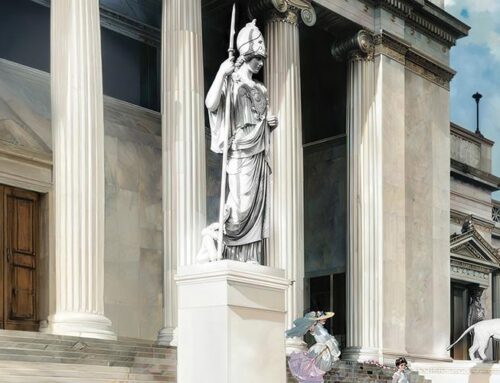
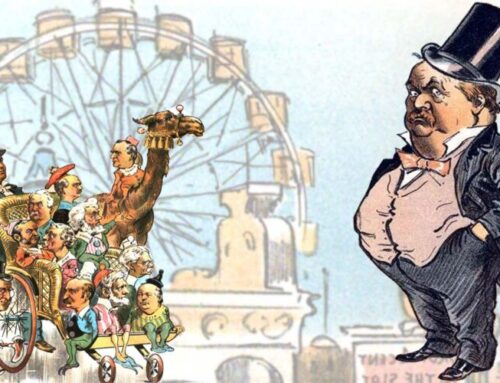
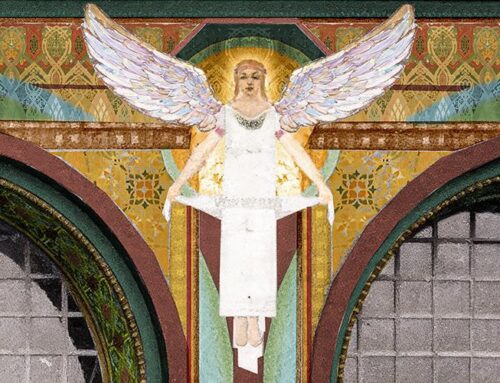
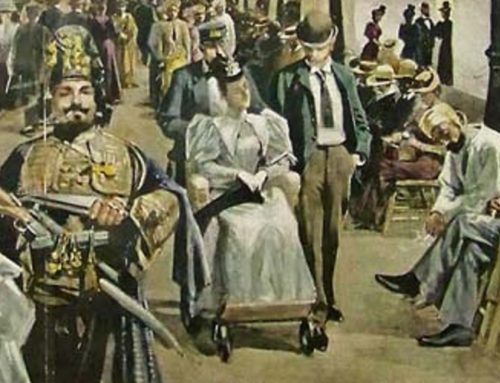

Leave A Comment